SEWING WITH CORK
A few years ago cork began to gain popularity in international online bag making circles. Bag pattern designers began to incorporate cork elements into their patterns, and bag makers began experimenting with cork, using it in place of leather and vinyl. Fast forward to today, and cork is commonly used for handbags & pouch and wallet exteriors by home based makers and high end commercial bag makers alike. Surprisingly, cork is easy to sew on domestic sewing machines, holds it shape, is durable and water resistant. It looks great too!
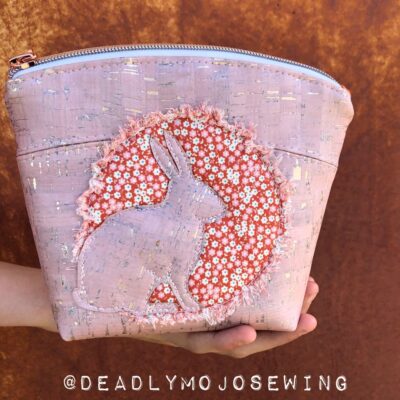
Cork is easy to sew on a domestic machine and holds it shape well. This one has a hand drawn & cut applique rabbit sitting over a sunset of fabric. The cork has a pearl finish.
WHAT IS CORK?
Often referred to as vegan leather or cork leather, cork is a sustainable, natural product that is harvested from Cork Oak trees. At this time, over 50% of cork comes from Portugal. When the trees are 25 years old, the bark can be harvested and the tree regenerates until the next harvest in 9 years. Cork Oak trees can live for about 200 years! The harvested cork is processed by a variety of methods that include drying and boiling the cork before gluing it to a backing and rolling it ready for distribution. Click here for some amazing pictures and information about the Cork Oak tree. This video shows the harvesting and processing of cork in Portugal. It is used to create a variety of items including wine corks, bags, shoes, cork boards and insulation. Did you know that cricket and baseballs have a cork core?

The lower section of this pouch is natural cork, it is so soft to hold and yet is very strong. This is a reverse applique with a Tula Pink Saltwater octopus hiding behind the hand cut anchor.
TIPS FOR PURCHASING CORK
Good quality cork feels light and strong and can be up to 1.1mm thick. Cork should not feel crunchy or look like it is peeling. When folded/scrunched it should spring back to its original shape. Be sure to buy from a reputable source as cork is an expensive product. Ask for a sample from your supplier if you are unsure about their quality. There is a great range of colours, textures and printed styles of cork available online. Note: Cork is not to be confused with ‘Uncorked” which is a range of look alike cotton fabric which is printed to look like cork. Uncorked cotton fabric is a good choice if you want the cork look but prefer sewing with cotton fabric.

There are many varieties of cork, these are from Porcupine Crafts.
Cork itself does not fray, however in my experience, the backing can sometimes fray if left as a raw edge in a high use area such as a raw bag strap. Different suppliers have different types of backing on their cork, some can feel fuzzy, some are black (usually on darker colours) and others are thin woven, only some of these backings fray. A little Fray Stop/Fray Check, washable glue or an edge coat product along the raw edge will help.

So much variety in the backings, keep in mind some backings do fray. But the cork itself does not fray.
MY FIRST CORK SEWING ADVENTURE
About 4 years ago I first discovered cork and was immediately taken with it’s texture and sewing potential. I had a small sample of green cork that inspired me to make a cactus. So I hand cut a Saguaro cactus. One cactus soon became two and then a landscape with stitched, textured detail.
It is layered with some gold and white leather and was free motion stitched with my 25 year old BERNINA 1530.
Check out the tiny details of the cactus flowers. Those spots are only about 3mm in diameter!
DO I NEED A SPECIAL SEWING MACHINE TO SEW CORK?
Absolutely not!
The awesome news is that your domestic BERNINA can sew cork! For the Posh Makeup Pouch project below, I used Nina the Pretty BERNINA B335 and at times she sewed through 2 layers of cork, zip, one layer of duck cotton, woven & fleece interfacing at the one time! She handled the layers of cork easily and is a great machine for sewing small zippered pouches like these. With the help of the tips & tricks below, and a little practice, you will work out what works best for you and your machine when sewing cork.
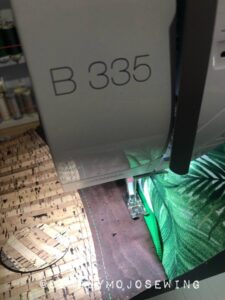
This cork was easy to topstitch on the cork with the Reverse Sole #1 foot that comes standard with the BERNINA B335
TIPS FOR SEWING WITH CORK
- Be confident! It is surprisingly easy to sew.
- Sewing scissors or a rotary cutter can be used to cut cork easily.
- Use a polyester thread.
- Use a size 80-90 universal or embroidery needle.
- If the layers are thick use a size 80-90 leather or denim needle.
- Use the Reverse Pattern Sole foot #1 or the Teflon Foot #52.
- The Three-sole Walking Foot #50 will get the the cork moving if you need extra help.
- Check your tension by doing a test sew with a ‘fabric sandwich’ before you start. Make your fabric sandwich with the same layers that you will sew. Adjust your tension if required.
- Tiny stitches may perforate the cork, so lengthen your stitches. Also be sure to increase the length of your stitches when topstitching to 5-5.50.
- To prevent holes in your cork from pins, use sewing clips or even bulldog clips to secure your pieces while you sew. Pins can be used in the seam allowance.
- Double sided tape or glue is helpful to hold small pieces in place. Avoid sewing through the tape or it may make your needle sticky and may cause skipped stitches.
- If you do have to unpick, try to re-sew into the same holes.
Let me know in the comments below if you have tried sewing cork? What did you make?
Until next time, have fun making all the beautiful things!
Kirrilee 🙂
Deadly Mojo Sewing
If you would like to follow my sewing adventures, you can find and follow me at Deadly Mojo Sewing on Facebook & Instagram.
PROJECT DETAILS FOR THIS BLOG POST
Cork: Porcupine Crafts (located in Australia). Or Aussie Cork on Facebook.
Pouch Pattern: Posh Makeup Bag Trio from Needle & Anchor Supply Co.
Bag hardware:Betty Box Pleat (Australian supplier)
Lining fabric: Spotlight Stores Australia
 BERNINA Corporate Blog -
BERNINA Corporate Blog -


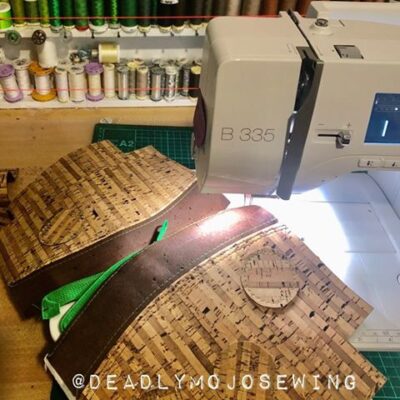


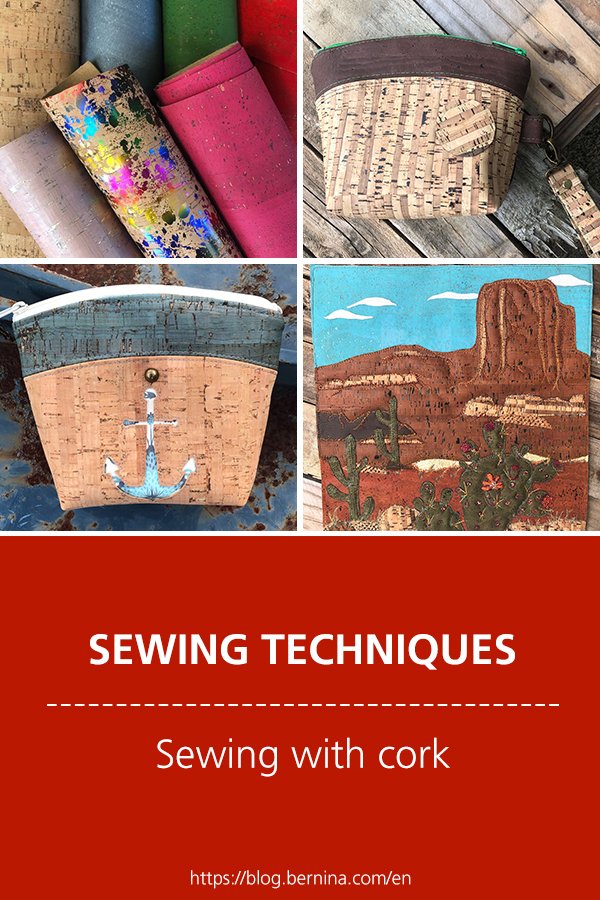
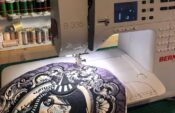
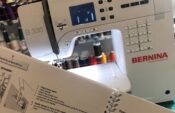
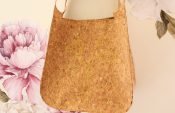

What kind of needle and thread would you recommend for cork? I know it probably depends on the thickness, but roughly 1mm and 2mm thick. I just bought Schmetz Jeans (90/14, 100/16, 110/18), Leather (110/18) and Universal (70/10, 80/12, 90/14, 100/16). And now I don’t know which is the appropriate one to use.I also bought Extra Strong 100% Polyester Güttermann thread and I am also not sure if this is appropriate to use on it. I just don’t want to mess up the material trying to figure it out, so any guidance would be helpful.Thank you!
By the way, I am making dog collars, leashes and purses with the cork I am using. So I need it to be extra strong. Hence, why I bought extra strong thread.
Dear Rebecca,
The author of this article has some good tips regarding the needle and stitchlength. Look for the part titled “TIPS FOR SEWING WITH CORK”
As you say it depends on the thickness, and you will have to do some tests with scraps to be sure the seam works and holds up. As long as the layers of the material are not too thick, use the Universal or Jeans needle, since they make smaller holes. If that does not work, use a leather needle. The leather needle cuts bigger holes, meaning thicker material is easier to get through, but it will increase the likeliness of the cork to rip. As the author says, you should increase the stitch length (especially if you have to use a leather needle) to counter the ripping. It’s best if you do some tests and try to rip the seam so you can check the strenght.
You can use the extra strong thread. The thickness will also make the top stitches appear more. To check which needle you should use for your thread, you can do this test:
Span the thread in a 45°-degree angle. Thread in the needle and let it glide along the thread. It should glide smoothly over the thread. If the needle bounces, jumps or sticks, it is too small for the selected thread. Increase the needle size by one step and repeat the test.
Maybe a collegue has some more tips, but that is all I can tell you right now. I hope it helps!
Kind regards, Ramona
Thank you so much! This is all very helpful and I appreciate it.
You are welcome!
My collegue with more sewing experience just added the following remark:
“A jeans needle is a good choice. A leather needle guides where the thread sits so it might work too. You will notice the stitch is slightly slanted. Cork is a great solution for simple projects that don’t have too many folds as after a while the cork can crumble a bit on the edges. This can depend on the quality of the material. Use a bigger stitch length with the extra strong thread (a nice choice of thread – as it is not so „sharp“ and you may need to tighten the top tension a little if there are loops underneath. Happy sewing!”
I’m contemplating making a case out of cork for a chess board and set that my fiance’ has made. I’d like to divide the case into two sides – 1 roughly 20 1/2″Hx20 1/2″Wx 2″D, the other side would be 3 1/2″D. Side and bottom seams would be sewn, with a zipper inserted at the top seam. Handles would be attatched on either side. Does anyone have any suggestions for what type of product I should use alongside the cork in order to add strength and cushioning to the case?
Dear Deb,
Are you planning on using a lining? I have not worked with cork, but I can imagine using either a quilted fabric or a lining with fusable batting to protect the selfmade chessboard, and the cork is the outer layer. Maybe you could even topstitch the layers together along the dividing seam. And maybe you could reinforce the cork on the handle sides with some kind of vliesline to make it sturdier. That’s how I would go about it.
Kind regards, Ramona
Nice article, the introduction is very specific and detailed. Cork is really a very good choice. They are not only environmentally friendly and natural, but also very unique and fashionable.
I have an Bernina 1010. Could anyone share what setting I would use to make cork bags/pouch.Thank you in advance.
Good morning!
You can use any stitches with the cork, the machine can handle it 🙂 In order to sew it together, the straight stitch 1 is just fine, or you can go with the tripple straight stitch, number 9 if you want to be really sure it holds together. Just as the tips say, you might want to lenghten the sitchlenght and try it out on a test piece first. I once used a too short straight stitch with leather, and the needle made so many holes, that the leather ripped at the seam. I never used cork, but maybe some corks are similar. So test the bond with your stitch, and you should do fine 🙂 Let me know if you need more help!
Best Regards, Ramona from BERNINA International
Enjoyed your article, I’m very tempted to now buy cork and have a go at using it in a project. I hope you don’t mind me asking the following here: I’m a programmer for Pieceful Nights Quilt Guild in Toronto, Canada. Do you or have you used cork in modern quilts at all? We are preparing our 2020/2021 Programme of Virtual Presenters and I wondered if you had a Trunk Show or Talk based on using cork in quilts as well as your bags etc.
I love sewing with cork. It’s so forgiving.
Great article Kirelee, congrats! Love Sewing with cork
Cork looks so amazing. Thanks for the tips ?